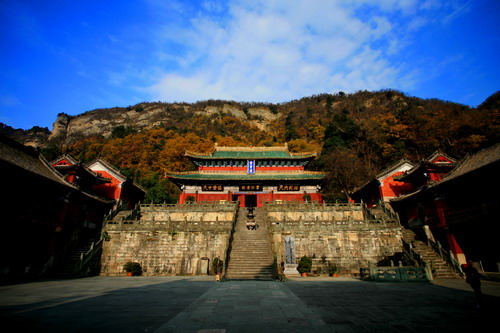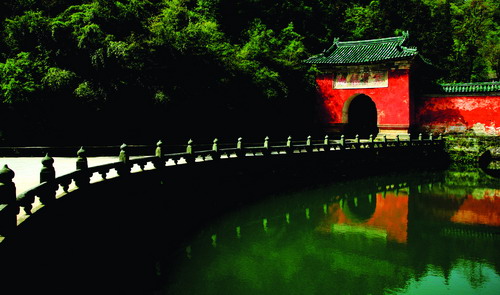Purple Heaven Palace (Zixiao Palace)
( chinadaily.com.cn )
Updated: 2011-07-11
 |
| Purple Heaven Palace (Photo by Lu Jialiang) |
 |
| Purple Heaven Palace (Photo by Yang Guangzhi) |
 |
| Purple Heaven Palace (Photo by Yang Guangzhi) |
Purple Heaven Palace is a historical site designated for state protection. The mountain behind the palace is named Zhanqi, which literally means a fluttering flag in the breeze. The shape of the mountain looks like an unfolded flag.
The Grand Hall inside Purple Heaven Palace is the only left double-eaves, lean-to wooden building. It is one of the rare examples of uplift wooden crossbeam construction in the history of the Taoist architecture.
This architectural complex has a floor space of 7,000 square meters. Along both sides of the axle you can see Dagon-Tiger Hall, the Pavilion Housing Imperial Stone Tablets, the Guest-Reception Hall, two side-halls and Parents Hall.
Most of the ancient buildings in China were made of wood. But wood rots easily and could not be planed in lengths wide enough to meet architectural needs of grand palaces. In order to overcome the disadvantages of timber, the constructions here were set up on high platforms, and the grand palace is composed of many smaller subdivisions.
The colored paintings on the timber of Purple Heaven Palace make the palace look beautiful and imposing, and also help to protect the timber from becoming rotten. The big Chinese characters on the lintel of the palace door have vigorous strokes. The four characters on the right horizontal board read xie zang zhong tian, and the characters on the middle one read shi pan liu tian. The words mean that the Zhenwu god, once was the ruler of Middle Heaven, stamped out the demons and brought peace in the Heavenly Palace. And the four characters on the left board read yun wai qing du, referring to the peaceful residence of immortals, which reflects the Taoist ideology of holding themselves apart from the world.
Purple Heaven Palace is where the Wudang Taoist prayed for the imperial family. The emperors in the Song, Yuan, Ming and Qing dynasties often issued orders to construct altars to bless and praise their ancestors in heaven. They also requested the assistance of the deities to ensure a prosperous people, good weather for the crops and a bumper grain harvest.



